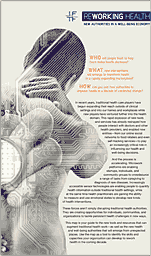Future Now
The IFTF Blog
Reworking Health: Coordinating Caring Communities
In the fall of 2012, The Huffington Post published Jane Ellen Stevens’s three-part overview on what Stevens claimed was “probably the most important public health study you never heard of.” Stevens, a seasoned health, science, and technology journalist, and now the founder and editor of the news site ACEs Too High, was writing about the CDC’s Adverse Childhood Experience Study—the ACE Study.
The ACE study is a collaboration with the Center for Disease Control and Prevention and Kaiser Permanente’s Health Appraisal Clinic in San Diego. It is one of the largest investigations ever conducted to assess associations between childhood maltreatment and later-life health and well-being. More than 17,000 people have undergone a comprehensive physical examination and shared detailed information about their childhood experiences of abuse, neglect and family dysfunction.
The findings of the study stunned the researchers. The data revealed that:
- There was a direct link between childhood trauma and adult onset of chronic and mental disease.
- About 2/3 of the adults in the study had experienced one or more types of adverse childhood experiences.
- Adverse childhood experiences were troublingly common. The participants of the study were predominantly white, middle class, middle-aged, and college educated.
Stevens’s contributions to The Huffington Post bring the overwhelmingly compelling and often concerning research about adverse childhood experiences and toxic stress to popular, mainstream culture. It’s not unlike Paul Tough’s 2011 profile in The New Yorker on Dr. Nadine Burke’s efforts to rethink primary care for the young patients she sees in Bayview-Hunters Point neighborhood of San Francisco by treating the effects of trauma and toxic stress to improve health outcomes. And it’s similar to the multi-part series of articles entitled “Tackling Toxic Stress” commissioned by the Center for the Developing Child at Harvard University. These articles showcase policymakers, researchers and practitioners implementing new approaches and services for children and families based on the science of early childhood development and an understanding of the consequences of adverse early experiences and toxic stress.
While these innovative approaches and novel experiments to understand, support and help people with untreated childhood trauma are varied and diverse, they mostly share a common characteristic at their core: they rely on community-based, or networked-based design.
In the United States, efforts such as the initiative launched by Robin Saenger in Tarpon Springs, Florida remind us that it is not always top-down authorities and clinical interventions that will solve our greatest health challenges. We know that successful prevention and treatment of trauma cuts across health care, education, crime, poverty, social mobility and workforce domains. It only makes sense, then, that designing and implementing effective interventions will require the skills and capabilities of an entire community. In the next decade, as research continues to uncover the links between adverse childhood experiences and later-life poor health, we could see effectiveness of these networked-based initiatives radically redefine what a health invention looks like.
In our 2013 Health Horizons research, Reworking Health, we examined four emerging sources of authority—computation, narratives, networks, and ambience—that will fundamentally transform who we trust and what interventions will be available in a rapidly expanding health and well-being marketplace.
This series of blog posts dives into the map's forecasts to reveal new opportunities and help you imagine what skills and capacities you or your organization can develop to rework health in the coming decade:
About IFTF's Health Horizons Program
- Contact Dawn Alva at dalva@iftf.org or 650-233-9585




